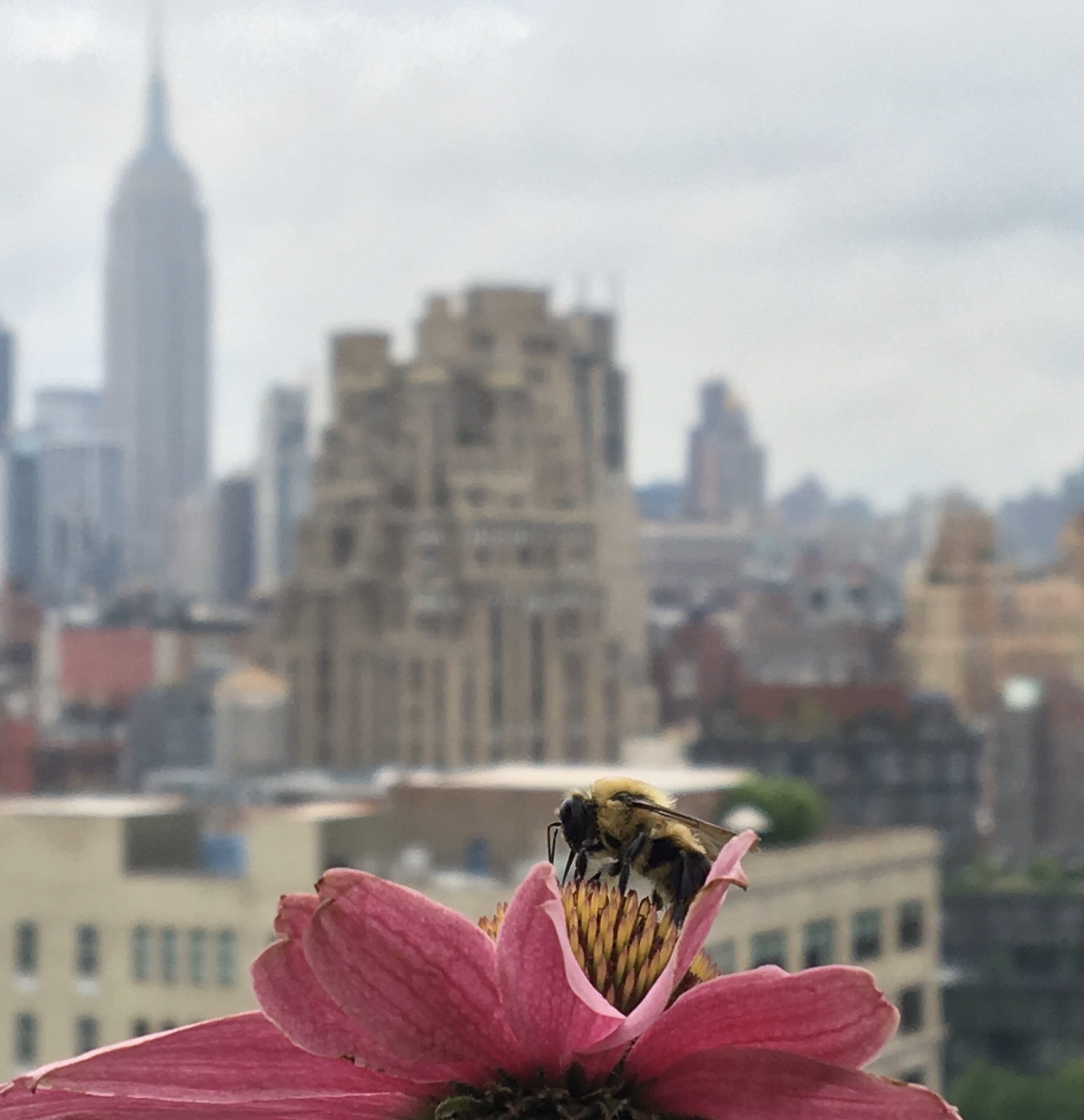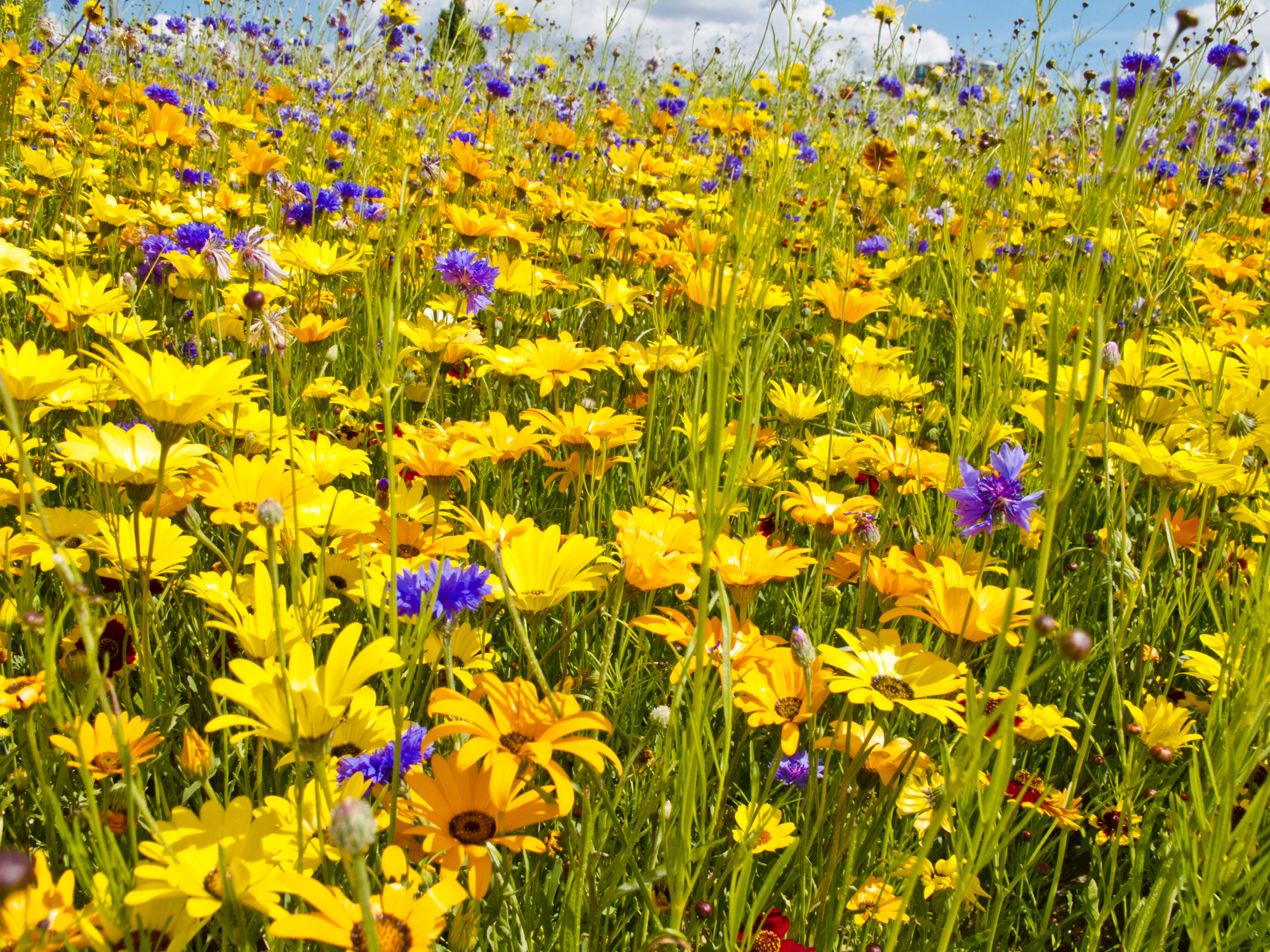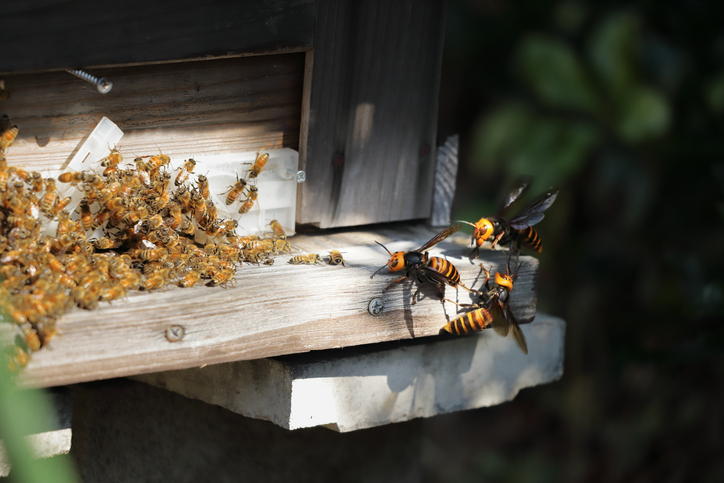Paving the way for more pollinators

Despite being made of concrete and stone, metropolitan areas are increasingly becoming havens for pollinators. Globally, cities are replacing groomed greenery with urban meadows and encouraging beekeeping. The concept of planting wildflowers to sustain bees has even caught on within the agrarian community.
On August 11, this year’s first giant Asian “murder hornet” was sighted in Washington State. An invasive species and a true thug, it preys and feeds on pollinators, complicating a rapidly unfolding global life struggle as it threatens our long-term food supply, which, to a large extent, depends on crops that need pollination.
In the countryside, the bees’ buffets of blossoms have been appropriated by extensive monocultures – growing one crop at a time over endless areas, resulting in short blooming periods, with flowers that, for the most part, don’t even offer the nectar bees require.
Intensive agriculture is nature’s bulldozer, utilizing vast amounts of fertilizers and pesticides to ensure ballooning harvests at the expense of soil health and pollinators. It has led to large-scale fragmentation, habitat degradation, and bee colony loss. Paradoxically, our race to feed more mouths might actually result in fewer full bellies.
City-dwellers will play an essential role in preserving biodiversity – and the declining number of bees – as housing developments, infrastructure, commercial edifices, etc., continue to take over what was once rural, flowering smorgasbords for bees. The UN predicts that 68% of the world’s population will have settled in urban areas by 2050.
Like humans, bees – both native bee species and domesticated honey bees – are relocating to urban environments, fleeing the countryside for metropolitan areas where they are less likely to encounter pesticides. “Cities with initiatives to create green spaces and limit the use of pesticides fare best when it comes to supporting bee diversity in general. In fact, a growing number of cities – such as Seattle – have banned pesticides on public lands,” explains Guillermo Fernandez, Founder and Executive Director of The Bee Conservancy, a New York-based organization that works to protect bees and secure environmental- and food justice through education, research, advocacy, and habitat creation.
Un-paving the concrete jungle
A recent review reported healthy native bee populations in metropolises from Melbourne, London, and Berlin, to San Francisco, Chicago, and New York City. In several places, there are more bees in cities than in surrounding rural areas.

Planting biodiversity-boosting, flowering meadows in urban areas has proven to enhance the conservation of pollinators. Bees thrive in blooming city environments that act as hotspots for bees’ pollination services and offer them food and shelter on prime real estate.
Bee-friendly urban gardens are sprouting worldwide. They might not be as manicured as the formal displays of cultivated flowerbeds we’re used to, but they’re kinder to the environment and cheaper to plant and maintain. These bohemian “prairies” form ecosystems that also support birds and other creatures, and their extended flowering periods are a relay race of varietals, delectable and vital to threatened pollinators. A study published in PLOS One scientific journal shows that perennial meadows produce 20 times more nectar and six times more pollen than annual versions, though pollinators are even grateful for weeds such as dandelions.
Cultivating less “coiffed” green spaces (that only need mowing twice a year) instead of cost- and chemical-intensive lawns also means curbing the substantial CO2 emissions produced by petrol- or diesel-powered mowers. What’s more, urban meadows have sturdier root systems that can retain larger quantities of water, making them drought-resistant and capable of absorbing heavy rains that might otherwise result in flooding. Add to that their capacity to filter pollution and smog, and it’s easy to see why these no-fuss green areas are becoming more popular.
In Germany, where almost half of the circa 580 native wild bee species are endangered, more than 100 “ungroomed” heaths have been planted in urban areas nationwide. Hamburg recently unveiled a series of flowerbeds on top of bus shelters. Berlin has set aside 1.5 million Euros to seed and nurture over 50 wild gardens, while Munich has already planted more than 30 of them in the past three years. Stuttgart, Leipzig, and Braunschweig have rolled out similar initiatives.
To the east, Polish entrepreneur Karol Podyma has established an educational foundation to raise awareness about urban meadows. Based in Warsaw’s outskirts, the eco-minded activist now sells wildflower seed kits and advises municipalities, locally and in Belarus, Russia, and Ukraine. By his own estimates, his seed company, Łąki Kwietne, sold enough seeds last year to plant an area equal to one million square meters.
To the west, the U.K. boasts the world’s largest urban meadow, the Queen Elizabeth Olympic Park in London. The country’s Department for Environment, Food, and Rural Affairs (Defra) coordinates an annual Bees’ Needs Week with conservation groups, businesses, charities, and academic institutions. The initiative highlights the importance of pollinators and teaches people how to support them.

Ultra-small-scale landscaping helps too. Anyone with a windowsill or a garden patch can aid the bees by planting flowers, trees, and shrubs. Avoiding pesticides should be obvious; not mowing down dandelions or yanking out flowering weeds does excellent service too.
Roadsides are another area that could use less primping. Not mowing them as regularly would actually provide far more pollinator forage than urban meadows.
Hive minds
Suddenly, in a “woke” moment for nature, people are starting to understand that bees are vital. Pollinators affect 35% of the world’s agricultural output. They impact the commercial and nutritional quality, the volumes, and the sustained production of 87 of the top 100+ human food crops.
Bees and other pollinators (birds, bats, butterflies) ensure food security and improve the quality of our nutrition – you could even say they fight hunger. Over 20,000 species of bees, both wild and domesticated, perform about 80% of all plant pollination worldwide; approximately 250,000 species of flowering plants need them to produce seeds. Grains are primarily pollinated by the wind, while bees pollinate fruits, nuts, seed crops, and most vegetables. Bees also pollinate fiber such as cotton and hay and alfalfa, grown to feed livestock; one could argue that they’re indirectly responsible for the t-shirt on your back and the milk in your coffee.
Urban beekeeping is buzzing
There was a time when hipsters would take butchering classes and nurture sourdough starters to cultivate a back-to-basics lifestyle. These days, people are turning to urban beekeeping, be it to bring a bit of farming spirit into the city sprawl or as a concerted effort to do something for the environment. The COVID-19 pandemic has given the practice a further boost as cooped up cosmopolites search for safe outdoor activities.
Larger apiaries and single beehives have popped up on rooftops and balconies, in backyards, public parks, school- and community gardens, and, in one extreme case, in a Manhattan bedroom where Andrew Coté, the president of the New York City Beekeepers Association, temporarily kept a colony that needed relocation. He estimates there are more than 600 hives in the Big Apple, including a 2.5m tall Empire State Building hive and a village of Dutch colonial houses, both courtesy of The Bee Conservancy. That’s rather paltry, though, compared to London, where hives have doubled in the past ten years to about 7,400. The number of urban beekeepers is rising by 200% annually, according to FAO, whose statistics also indicate that there are 90 million honey bee hives globally. The organization initiated World Bee Day in 2018, celebrated annually on May 20, a date chosen to honor Anton Janša, the pioneer of modern apiculture, born in 1734, in Slovenia, a nature-loving republic where apiculture has a rich history, both as an agricultural activity, and as an urban enterprise; the town of Idrija has kept a municipal apiary for nearly 100 years.
“The magic of urban beekeeping is seeing the impact the practice has not just on local ecology in parks, community gardens, and beyond, but also for urban individuals who get a chance to connect with nature and the creatures responsible for the food and foliage they love. The concrete jungle is still a jungle, and the chance to create wonder and engagement with the tiny pillars of our ecosystem helps foster future generations of environmental stewards,” assures Fernadez, adding that “if you want local food, you really need to have local bees. And recent research has revealed that by placing bees in a community farm or garden, you can increase crop yield by up to 70%.”
Urban apiculture can also be a tool for social change. Fernandez grew up in what he calls a ”food desert; a low-income area with limited access to nutritious food”. He founded The Bee Conservancy to alleviate hunger and support food security through bee conservation. The organization empowers low-income communities to care for bees and educate them about bee conservation.
“Beekeeping is expensive, so we created Sponsor-A-Hive to gift wild bee houses and honey bee hives to community organizations that were doing incredible work but couldn’t afford their own beehives. We strategically award and place these pollinators in community and school gardens and urban farms that provide locally grown food to soup kitchens, senior citizen centers, and other vulnerable populations. These beehives also act as educational hubs in their community. We provide hours of training and technical support to ensure the bees thrive,” says Fernandez.
The buzzkill
As valiant urban beekeeping might be for (primarily imported) honey bees, native pollinators aren’t appreciating the gesture. Honey bees threaten their health and survival; they overpopulate green areas and hog the forage, making it harder for wild species to feed themselves and survive. The London Beekeepers’ Association (LBKA) estimates that one honey bee hive will consume 250 kg of nectar and 50 kg of pollen before the honey crop is collected. Wild pollinators just can’t keep up with the competition; they may well die out.
Alarmingly, there’s ample evidence that we’re heading toward a sixth major extinction of biological diversity. A third of the insect species worldwide are endangered. Insect abundance has declined by 75% in the past 50 years, with catastrophic impacts on our food chain. Current pollinator extinction rates are 100 to 1,000 times higher than normal due to human impacts, notably intensive monocropping and its use of pesticides. As a result, many bee and butterfly species could well disappear, amounting to a 40% biodiversity loss. This also affects birds, frogs, fish, and other creatures that feed on insects.
Making matters worse, bees are tremendously affected by climate change, according to a team of researchers at Penn State University. Their January 2021 study, featured in Science Daily, concluded that the most critical factor influencing wild bee abundance and species diversity was the weather, particularly temperature and rainfall, which are more important than the amount of suitable habitat or floral and nesting resources. Different bee species are affected by different weather conditions. For example, areas with more rain had fewer spring bees as rain limits their ability to collect food. Warm winters have caused plants to bloom earlier; when bees – who are used to specific climate cues – come out of hibernation, the flowers they need to feed on have already died. These balmy cold seasons, combined with longer, hotter summers that frazzle all blooms, lead to higher average temperatures that, in turn, cause reductions in bees’ body mass and fat content and higher mortality and shorter life spans.
Droughts, floods, and other extreme climate events also hinder pollination primarily by desynchronizing the demand (flowers in bloom) with the supply of service providers (abundant and diverse populations of pollinators).
The threat from within
“Competitive species are also a concern, notably the Africanized ”killer” bee and the Asian ”murder” hornet that recently gate-crashed the Northwest U.S. for the second year in a row”

If mismanaged, beehives can become cramped Petri dishes of contagion because they’re densely populated and often stacked close together. The diseases honey bees foster can easily spread to native pollinators – that are, incidentally, “better than honey bees at pollinating native crops such as berries (pollinated by blueberry bees), avocado (by stingless bees), and cucumber (by squash bees).”
So far, more than 20 honey bee viruses have been identified. They can kill developing offspring, decrease the life span of adult bees, cause spasms and tremors, reduce cognitive skills, and impair wing development. Most honey bee colonies have multiple viruses that fluctuate throughout the year.
Parasites also bring sickness and ruin. Varroa destructor has so far caused the most damage. Discovered in Southeast Asia in 1904, this invasive mite reached Europe and North America in the 1980s and has now spread almost worldwide. About the size of a pinhead, it feeds on bees’ “blood” and spreads from one hive to another, transmitting viral diseases and bacteria while reproducing on honey bee brood (developing larvae or pupae). Eventually, at high infestation rates, the mites overwhelm and kill the host colony.
Another menace to honey bees is the Nosema ceranae, a microscopic fungus that can weaken or even wipe out colonies. Spores of the fungus survive on wax combs and stored food inside colonies. When worker bees eat them, the fungus invades the lining of the intestine. If highly infected, bees cannot digest efficiently and die prematurely. Beekeepers disinfect hives and use antibiotics (fumagillin) to control the disease. However, there is evidence that fumagillin is toxic, causing chromosomal aberrations, carcinogenicity in humans, and alterations to the bee’s hypopharyngeal gland (the gland that contributes to making royal jelly). Many countries outside the Americas, including the EU, have banned it for agricultural use.
Competitive species (with evocative names) are also a concern, notably the killer bee and the murder hornet that recently gate-crashed the Northwest U.S. for the second year in a row. The latter can exceed 5 cm and feeds on other insects, including honey bees.
Then there’s Colony Collapse Disorder, an abnormal phenomenon, first recorded in 2006. It causes worker bees to mysteriously and abruptly die en masse, leaving a bounty of food as well as their queen and her offspring behind. The syndrome has been observed in the United States, most of Europe, as well as some African and Asian countries, particularly in Egypt and China. The UN Environmental Programme addressed the emerging problem already in 2010 in its exhaustive report, Global bee colony disorders and other threats to insect pollinators.
The anthropocene threats
Humans, many of us at least, are directly contributing to a fair share of damage. The air pollution we cause thwarts the symbiotic relationship between pollinators and flowers. Although daytime insects depend primarily on vision to find flowers, pollutants affect the chemicals flowers produce to attract insects, destroying scent trails. Aromas that could travel over 800 m in the 1800s now reach less than 200 m from the plant, complicating pollinators’ ability to locate food sources.
Electric and magnetic fields emanating from, e.g., power lines and cellphone towers may also influence bee behavior, impairing cognitive and motor abilities. Bees are highly attracted to electromagnetic radiation. When in use, mobile phones project electromagnetic waves that interfere with the bees’ navigation system, confusing them enough to make them forget how to find their way back home. Yet another reason to put down that device! (Even though there is currently insufficient data and research to establish a causal link between the impact of these fields and bee mortality.)
The industrial agribusiness is wreaking havoc with its use of neonicotinoids, or neonics, a class of synthetic insecticides that have become the industry’s pest-fighter of choice. First marketed in the mid-1990s, their adoption was rapid, making them the most widely applied insecticide today. When absorbed by plants, their poison manifests itself in pollen and nectar, which is then consumed by bees that consequently meet their death. But this is no instantaneous euthanasia. The poison fuses to the bees’ nerve cells, leaving the insects uncontrollably shaking and twitching before they go into paralysis and die. By then, they might have brought the toxin back to their hives, sharing it with their colony to effectively cause mass mortality.
Biologists have found more than 150 different chemical residues in bee pollen – a deadly ”pesticide cocktail”, as University of California apiculturist Eric Mussen puts it.
Green policies to ensure crop biodiversity
The recent Swedish campaign Hela Sverige blommar (All of Sweden is in Bloom) ensured that the equivalent of 1,000 soccer fields blossomed in time for Midsummer. Countrywide, 700 farmers contributed by sowing pollinator-friendly forage in field edges and fallow soil; buckwheat, clover, sunflowers, borage, and other pollen- and nectar-rich species that attract both bees and insects, providing food for birds to boot. These flowering zones also protect field game, deer, and other critters.
Hela Sverige blommar was sparked by the EU’s “green direct payment” policy that compensates farmers who adopt or maintain practices that help meet environmental and climate goals. “Greening”, as it’s also known, mandates crop diversification and upkeep of permanent grasslands that sequester carbon and protect biodiversity; it also dictates that 5% of arable land be left untouched to sustain biodiversity and habitats. The idea was to support the pollinators and create some beauty – instead of leaving those land patches unkempt?
This past spring, the Swedish University of Agricultural Sciences started researching 19 of the participating farms, quickly recognizing that the planted zones do indeed attract far more pollinators than those left to grow wild.